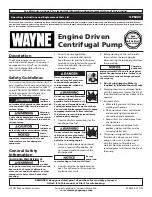
5
4.3 Pump Position
The pump may be operated in either the horizontal or
vertical position. See Figure 7.
When operated in the vertical position, hose end of
pump must be pointed down, or the pump will pick
up air and will not properly build pressure.
Note:
The pump is not designed for use in the
inverted (upside-down) position.
OK
OK
Figure 7, Pump Orientation
5.0 OPERATION
5.1 Before Using the Pump
1. Check all system fittings and connections to be
sure they are tight and leak free.
2. Check oil level in reservoir and add oil if required.
Refer to instructions in Section 9.1.
3. Read and understand the following precautions
before operating pump:
WARNING:
In certain situations the pump
handle can “kick back”. Always keep your
body to the side of the pump, away from
the line of force of the handle.
WARNING:
When operating the pump
handle, keep hands and fingers away from
pinch point area between pump handle
and lifting/transport handle.
CAUTION:
Always remove shipping
plug(s) from pump outlet port(s) and
replace with proper hydraulic fitting(s)
before operating pump handle. If pump handle is
operated with shipping plug(s) installed, plug(s) could
eject from port(s) with great force, resulting in
possible personal injury.
CAUTION:
Never add extensions to pump
handle. Extensions cause unstable pump
operation.
CAUTION:
To
prevent
mechanical
damage, do not pull on pump handle after
it has reached the end of its travel. Do not
apply side force to pump handle.
IMPORTANT:
To reduce handle effort at high
pressure, take short strokes. Maximum leverage is
obtained in the last 5 degrees of stroke.
5.2 Two Stage Flow
Models P-77, P-80, P-801 and P-84
Two-speed pumps provide two stage flow. Under
no-load, the pump operates in the high flow first
stage for rapid advance. When the load is contacted,
the pump automatically shifts to the second stage
for building pressure. After the pump shifts, pumping
takes less effort.
Note:
For best performance, operate pump handle
at moderate speed during the high flow first stage.
Rapid handle speed in the first stage will prevent the
pump from delivering full volume of oil.
5.3 Pump Operation
Models P-18, P-39, P-77, P-80 and P-801
All pump models except the P-84 are designed for
use with single-acting cylinders and are equipped
with an integral release valve.
1. Close the release valve by turning knob clockwise
until it stops. See Figure 8.
CAUTION:
Close release valve finger tight
ONLY. Using tools on release valve can
damage it and cause the pump to
malfunction.
2. Operate pump handle to deliver hydraulic power
to system. Pressure will be maintained until
release valve is opened.
3. Open the release valve by turning knob counter-
clockwise. Pressure will be released, allowing oil
to flow back to the reservoir.
CLOSE
OPEN
Figure 8, Release Valve (all except P-84)
CAUTION:
If release valve knob is difficult
to turn or becomes stuck, immediately
discontinue using pump. Have pump
inspected and repaired by an Enerpac Authorized
Service Center.




























